新概念英语第一册111144课语法复习
- 格式:pptx
- 大小:399.83 KB
- 文档页数:37
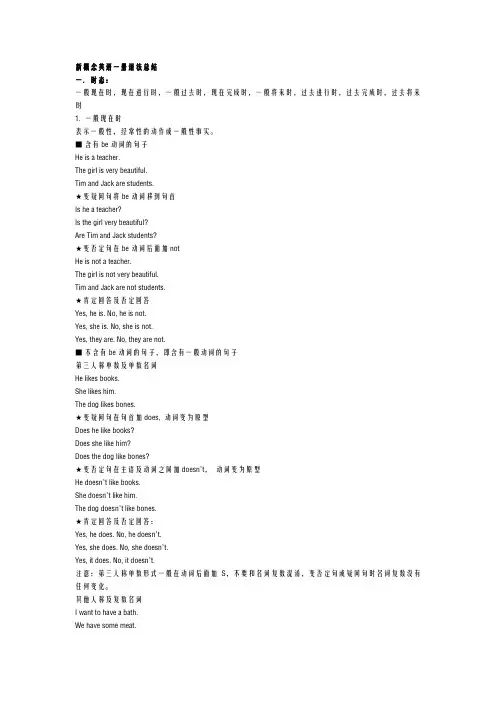
新概念英语一册语法总结一.时态:一般现在时,现在进行时,一般过去时,现在完成时,一般将来时,过去进行时,过去完成时,过去将来时1. 一般现在时表示一般性,经常性的动作或一般性事实。
■含有be动词的句子He is a teacher.The girl is very beautiful.Tim and Jack are students.★变疑问句将be动词移到句首Is he a teacher?Is the girl very beautiful?Are Tim and Jack students?★变否定句在be动词后面加notHe is not a teacher.The girl is not very beautiful.Tim and Jack are not students.★肯定回答及否定回答Yes, he is. No, he is not.Yes, she is. No, she is not.Yes, they are. No, they are not.■不含有be动词的句子,即含有一般动词的句子第三人称单数及单数名词He likes books.She likes him.The dog likes bones.★变疑问句在句首加does, 动词变为原型Does he like books?Does she like him?Does the dog like bones?★变否定句在主语及动词之间加doesn’t,动词变为原型He doesn’t like books.She doesn’t like him.The dog doesn’t like bones.★肯定回答及否定回答:Yes, he does. No, he doesn’t.Yes, she does. No, she doesn’t.Yes, it does. No, it doesn’t.注意:第三人称单数形式一般在动词后面加S,不要和名词复数混淆,变否定句或疑问句时名词复数没有任何变化。
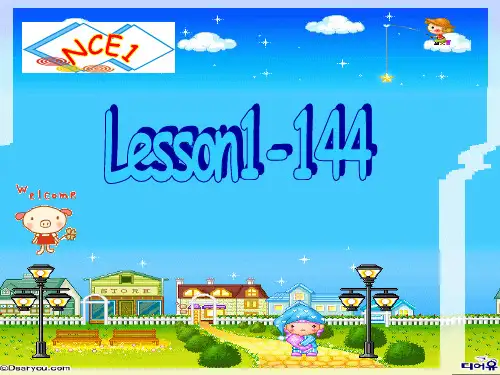
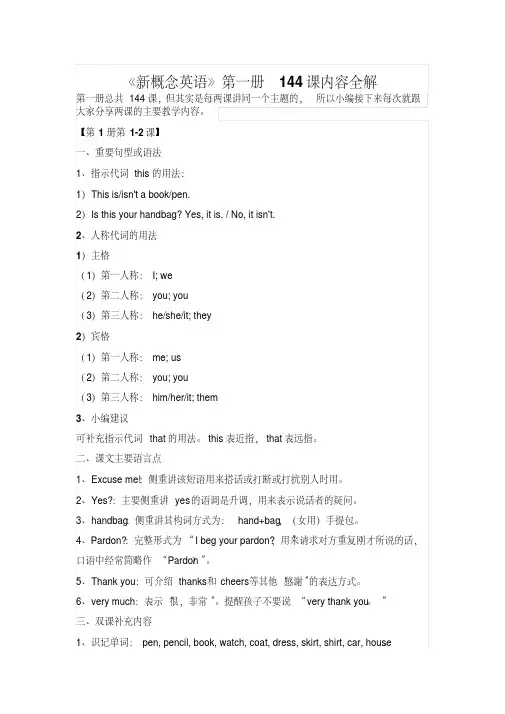
《新概念英语》第一册144课内容全解第一册总共144课,但其实是每两课讲同一个主题的,所以小编接下来每次就跟大家分享两课的主要教学内容。
【第1册第1-2课】一、重要句型或语法1、指示代词this的用法:1)This is/isn't a book/pen.2)Is this your handbag? Yes, it is. / No, it isn't.2、人称代词的用法1)主格(1)第一人称:I; we(2)第二人称:you; you(3)第三人称:he/she/it; they2)宾格(1)第一人称:me; us(2)第二人称:you; you(3)第三人称:him/her/it; them3、小编建议可补充指示代词that的用法。
this表近指,that表远指。
二、课文主要语言点1、Excuse me!:侧重讲该短语用来搭话或打断或打扰别人时用。
2、Yes?:主要侧重讲yes的语调是升调,用来表示说话者的疑问。
3、handbag:侧重讲其构词方式为:hand+bag,(女用)手提包。
,用来请求对方重复刚才所说的话,4、Pardon?:完整形式为“I beg your pardon?”口语中经常简略作“Pardon?”。
5、Thank you:可介绍thanks和cheers等其他“感谢”的表达方式。
6、very much:表示“很,非常”。
提醒孩子不要说“very thank you”三、双课补充内容1、识记单词:pen, pencil, book, watch, coat, dress, skirt, shirt, car, house。
2、数字:1-10四、语用主题失物招领的问答。
———————【第1册第3-4课】———————一、重要句型或语法1、指示代词this的用法:1) This is not my umbrella.2) Is this your ...? Yes, it is. / No, it isn't.3) Is this it? Yes, it is. / No, it isn't.2、人称代词的用法it的用法:用来指代前面刚刚提到过的事物。
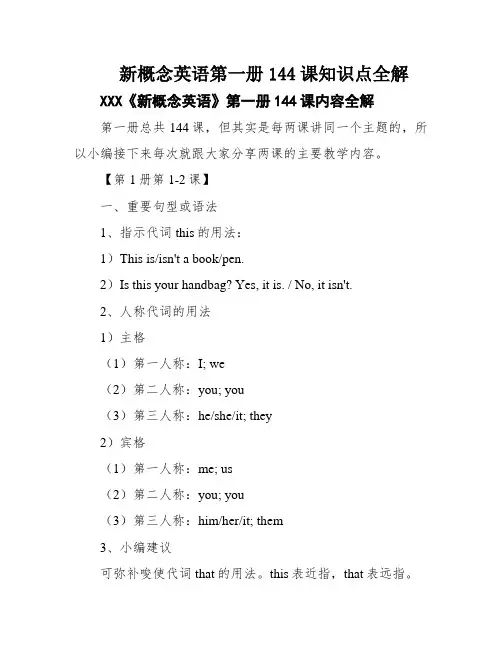
新概念英语第一册144课知识点全解XXX《新概念英语》第一册144课内容全解第一册总共144课,但其实是每两课讲同一个主题的,所以小编接下来每次就跟大家分享两课的主要教学内容。
【第1册第1-2课】一、重要句型或语法1、指示代词this的用法:1)This is/isn't a book/pen.2)Is this your handbag? Yes, it is. / No, it isn't.2、人称代词的用法1)主格(1)第一人称:I; we(2)第二人称:you; you(3)第三人称:he/she/it; they2)宾格(1)第一人称:me; us(2)第二人称:you; you(3)第三人称:him/her/it; them3、小编建议可弥补唆使代词that的用法。
this表近指,that表远指。
2、课文主要语言点1、Excuse me!:侧重讲该短语用来搭话或打断或打扰别人时用。
2、Yes?:主要偏重讲yes的语调是升调,用来透露表现语言者的疑问。
3、handbag:侧重讲其构词方式为:hand+bag,(女用)手提包。
4、Pardon?:完整形式为“I beg your pardon?”,用来请求对方重复刚才所说的话,口语中经常简略作“Pardon?”。
5、Thank you:可介绍XXX和cheers等其他“感谢”的表达方式。
6、very much:表示“很,非常”。
提醒孩子不要说“very thank you”。
三、双课弥补内容1、识记单词:pen, pencil, book, watch, coat, dress, skirt, shirt, car, house。
2、数字:1-10四、语用主题失物招领的问答。
———————【第1册第3-4课】———————一、重要句型或语法1、唆使代词this的用法:1) This is not my XXX.2) Is this your ...? Yes, it is. / No, it isn't.3) Is this it? Yes, it is. / No, it isn't.2、人称代词的用法it的用法:用来指代前面刚刚提到过的事物。
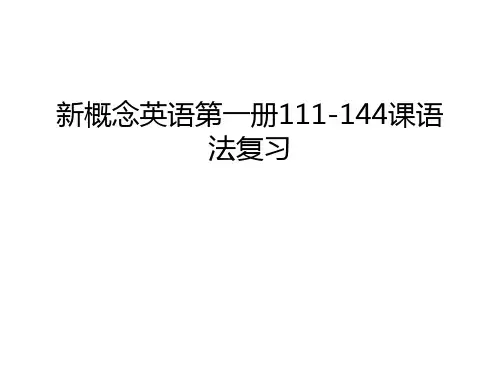
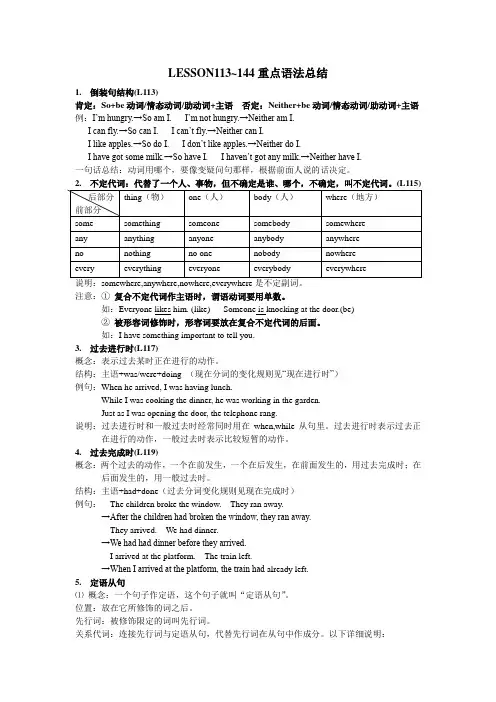
LESSON113~144重点语法总结1.倒装句结构(L113)肯定:So+be动词/情态动词/助动词+主语否定:Neither+be动词/情态动词/助动词+主语例:I’m hungry.→So am I. I’m not hungry.→Neither am I.I can fly.→So can I. I can’t fly.→Neither can I.I like apples.→So do I. I don’t like apples.→Neither do I.I have got some milk.→So have I. I haven’t got any milk.→Neither have I.一句话总结:动词用哪个,要像变疑问句那样,根据前面人说的话决定。
注意:①复合不定代词作主语时,谓语动词要用单数。
如:Everyone likes him. (like) Someone is knocking at the door.(be)②被形容词修饰时,形容词要放在复合不定代词的后面。
如:I have something important to tell you.3.过去进行时(L117)概念:表示过去某时正在进行的动作。
结构:主语+was/were+doing (现在分词的变化规则见“现在进行时”)例句:When he arrived, I was having lunch.While I was cooking the dinner, he was working in the garden.Just as I was opening the door, the telephone rang.说明:过去进行时和一般过去时经常同时用在when,while从句里。
过去进行时表示过去正在进行的动作,一般过去时表示比较短暂的动作。
4.过去完成时(L119)概念:两个过去的动作,一个在前发生,一个在后发生,在前面发生的,用过去完成时;在后面发生的,用一般过去时。
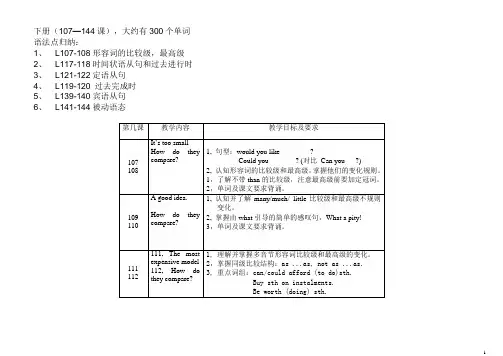
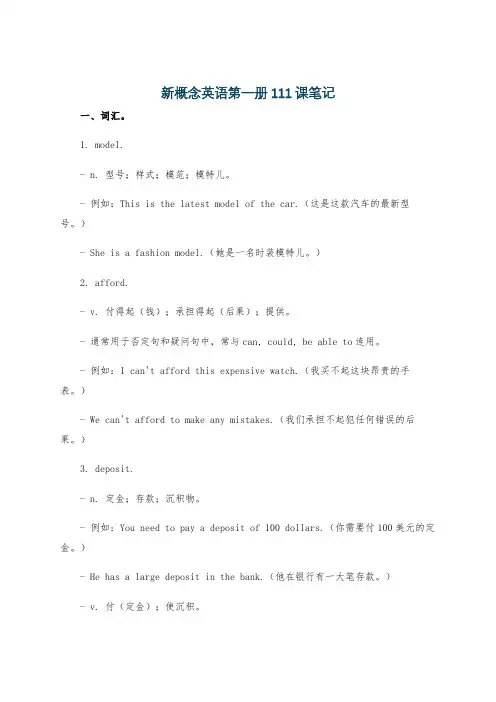
新概念英语第一册111课笔记一、词汇。
1. model.- n. 型号;样式;模范;模特儿。
- 例如:This is the latest model of the car.(这是这款汽车的最新型号。
)- She is a fashion model.(她是一名时装模特儿。
)2. afford.- v. 付得起(钱);承担得起(后果);提供。
- 通常用于否定句和疑问句中,常与can, could, be able to连用。
- 例如:I can't afford this expensive watch.(我买不起这块昂贵的手表。
)- We can't afford to make any mistakes.(我们承担不起犯任何错误的后果。
)3. deposit.- n. 定金;存款;沉积物。
- 例如:You need to pay a deposit of 100 dollars.(你需要付100美元的定金。
)- He has a large deposit in the bank.(他在银行有一大笔存款。
)- v. 付(定金);使沉积。
- 例如:I deposited 500 yuan on this apartment.(我为这套公寓付了500元定金。
)- The river deposits a lot of sand at its mouth.(这条河在河口沉积了大量的沙子。
)4. installment.- n. 分期付款;(分期连载的)部分。
- 例如:I bought this TV on installments.(我用分期付款的方式买了这台电视。
)- The story is published in installments.(这个故事分期连载。
)5. price.- n. 价格;代价。
- 例如:The price of this book is 20 yuan.(这本书的价格是20元。
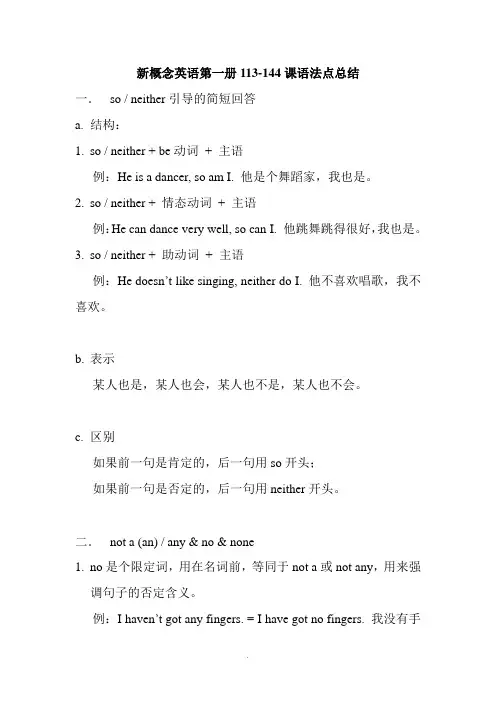
新概念英语第一册113-144课语法点总结一.so / neither引导的简短回答a.结构:1.so / neither + be动词+ 主语例:He is a dancer, so am I. 他是个舞蹈家,我也是。
2.so / neither + 情态动词+ 主语例:He can dance very well, so can I. 他跳舞跳得很好,我也是。
3.so / neither + 助动词+ 主语例:He doesn’t like singing, neither do I. 他不喜欢唱歌,我不喜欢。
b.表示某人也是,某人也会,某人也不是,某人也不会。
c.区别如果前一句是肯定的,后一句用so开头;如果前一句是否定的,后一句用neither开头。
二.not a (an) / any & no & none1.no是个限定词,用在名词前,等同于not a或not any,用来强调句子的否定含义。
例:I haven’t got any fingers. = I have got no fingers. 我没有手指。
I haven’t got a long tail. = I have got no long tail. 我没有一条长尾巴。
2.none: 没有人;一个也没有;一点儿也没有例:He has got many interesting books. I have got none.他有很多有趣的书,我一本也没有。
三.不定代词either; both; all; neither; none注意:either表示两者任选其一。
例:Which one do you want, an apple or a pear? Either is Okay.你想要苹果还是梨?都可以。
Either of my parents will come to see you. 我爸爸或者妈妈会来见你。
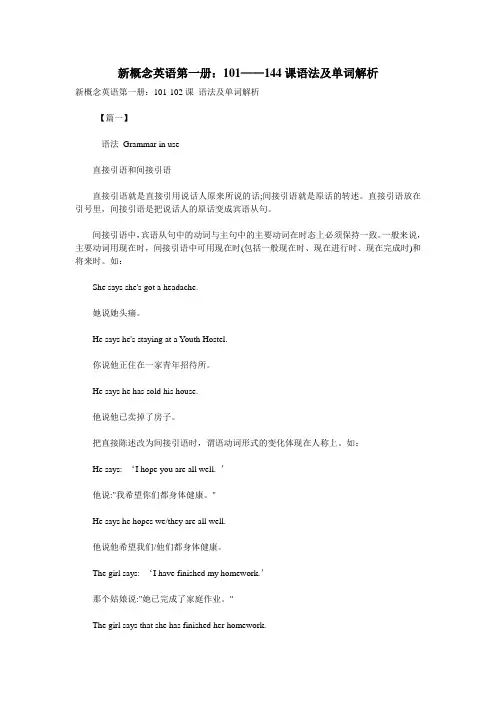
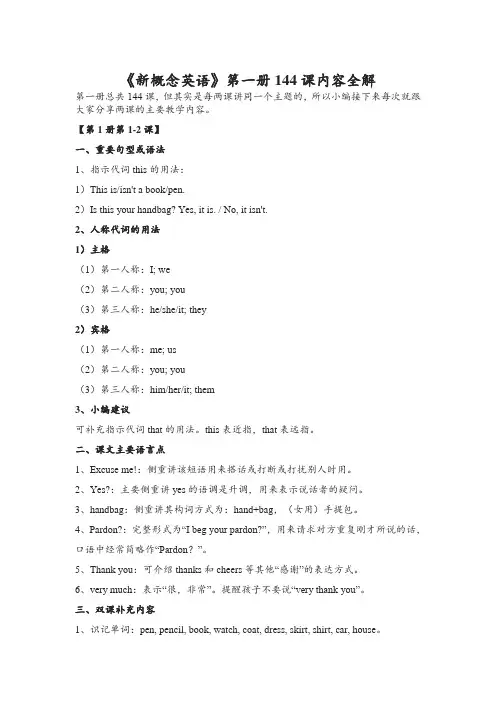
《新概念英语》第一册144课内容全解第一册总共144课,但其实是每两课讲同一个主题的,所以小编接下来每次就跟大家分享两课的主要教学内容。
【第1册第1-2课】一、重要句型或语法1、指示代词this的用法:1)This is/isn't a book/pen.2)Is this your handbag? Yes, it is. / No, it isn't.2、人称代词的用法1)主格(1)第一人称:I; we(2)第二人称:you; you(3)第三人称:he/she/it; they2)宾格(1)第一人称:me; us(2)第二人称:you; you(3)第三人称:him/her/it; them3、小编建议可补充指示代词that的用法。
this表近指,that表远指。
二、课文主要语言点1、Excuse me!:侧重讲该短语用来搭话或打断或打扰别人时用。
2、Yes?:主要侧重讲yes的语调是升调,用来表示说话者的疑问。
3、handbag:侧重讲其构词方式为:hand+bag,(女用)手提包。
4、Pardon?:完整形式为“I beg your pardon?”,用来请求对方重复刚才所说的话,口语中经常简略作“Pardon?”。
5、Thank you:可介绍thanks和cheers等其他“感谢”的表达方式。
6、very much:表示“很,非常”。
提醒孩子不要说“very thank you”。
三、双课补充内容1、识记单词:pen, pencil, book, watch, coat, dress, skirt, shirt, car, house。
2、数字:1-10四、语用主题失物招领的问答。
———————【第1册第3-4课】———————一、重要句型或语法1、指示代词this的用法:1) This is not my umbrella.2) Is this your ...? Yes, it is. / No, it isn't.3) Is this it? Yes, it is. / No, it isn't.2、人称代词的用法it的用法:用来指代前面刚刚提到过的事物。
《新概念英语》学什么:第1册第143-144课新概念英语》学什么:第1册第141-142课接下去我们来看第143-144课的内容:一、重要句型或语法1、被动语态本课侧重的是一般现在时、现在完成时、一般将来时和一般过去时中的被动语态的用法,如:I live in a very old town which is surrounded by beautiful woods.Visitors have been asked to keep thewoods clean and tidy.Anyone who leaves litter in these woods will be prosecuted!二、课文主要语言点I l i v e in a very old townwhich is surrounded by beautiful woods.1)which引导的定语从句修饰a very old town。
可复习一下关系代词引导的定语从句的用法。
2)be surrounded by,被...环绕。
本句中的被动语态采用的是一般现在时。
3)woods,树林。
wood原形一般用作不可数名词,表示树木、木头。
It is a famo us beauty spo t.beauty spot,景点。
相当于scenic spot或place of interest。
beauty是名词,其形容词为beautiful;spot表示地点、现场。
On Sundays, h undreds of pe ople come fro m the cityto see our t own and to w alk through t he woods.1)on Sundays中的Sunday用了复数,表示频率,即经常在周日。
2)hundreds of,成百上千。
注意“数词的复数+of”结构,表示的是概数,即不确定的数字,其前面不能再加表示具体数量的数词。
L1~L2讲义:一、难点及重点词:excuse 原谅pardon 原谅,请再说一遍二、重点句子:1.Is this your handbag ?2.pardon = I beg your pardon ?3.Yes, it is .三、重要知识点:1.Excuse me 与sorry的区别:me: I 的宾格.Excuse me: 为了引起别人的注意力,而用的客套说法,事前使用。
Sorry: 犯错误之后,事情发生后的使用。
2.Yes. 是的→ 什么事(本课)用升调读。
3.Yes, it is. Yes,是的,肯定回答。
it 指上文的handbag.4.Thank you very much = Thanks a lot. 答语:You’re welcome.5.be动词用法歌:我是am,你是are,is用于她,他,它,单数is,复数are.6.pardon = I beg your pardon ?四、语法:一般疑问句Is this your handbag ? be动词的一般疑问句,用yes/no回答的疑问句:①一般疑问句相当于我们汉语中的问句,以“吗”结尾。
② be包括is, am, are “是”③由肯定句转化成一般疑问句的步骤为:⑴把be动词提前,小写变大写.⑵主语移后大写变小写.⑶后面不动落下来.⑷句号变问号,降调变升调.L3~L4讲义:难词及重点词:L3~L4讲义:一、难词及重点词:umbrella伞my我的ticket票cloakroom衣帽存放处daughter女儿二、重点句子:1.My coat and my umbrella please.Please give me my coat and my umbrella.2.This is not my umbrella.3.Is this your umbrella ?4.Is this it ?5.Here is my ticket.三、重要知识点:1.区分sir/Mr.Mr.需和姓连用,用在姓前,如Mr. WuSir可单独使用,Yes, sir. 与姓连用时,放在姓后, 如Zhang sir.2.Here’s = Here isHere’s 区分this is 这是… :This is : 东西在这摆着,静止。
新概念英语第一册1-144课语法点总结1.物主代词2.人称代词3.Be动词Be动词有am, is ,are,过去式是was, were •根据主语的变化而变化。
4.一般疑问句定义:是指可以用yes或者no回答的句子。
肯定句变疑问句:肯定句中存在be动词,直接be动词提句首,结尾加问号。
若肯定句中存在情态动词,则情态动词提句首,后面加问号。
若肯定句中存在实意动词,则直接在句首加助动词do/does/did ,实意动词变原形,结尾加问号。
5.特殊疑问句定义:不能用yes或者no回答的句子。
构成:特殊疑问词+—般疑问句特殊疑问词有:what (什么),when (何0t),where (何地)'who (谁)‘ whom (谁宾格),whose (谁的),which (哪个),why(为什么),how (怎么样). 口诀:8wlh.6.不定冠词a/ an以a,e z i,o,开头的单词前,表示一个的要用an •若单词以u开头的单词,视情况而定,发本身因时,前面加a.其他加an.若一个字母单独出现时,加an的字母:a,e,i,o;x,r, s, l,n,f,m,h(学而思送来那份美好)7.形容词用法:形容词多放在名词或代词前而,对他们起修饰或限定作用。
通常用来说明人或事物的大小,颜色,形状或者特征等。
注意:当形容词单独出现时,前面不可加a/an・如果一个名词前有多个形容词修饰,排字口诀:美小圆旧黄,法国木书房。
8.名词所有格。
构成:一般情况下,有生命的直接在名词后加's.无生命的用of含义:名词所有格表示…••…的若名词变复数后词尾有S的,直接加'即可。
9 •名词复数的规则变化:一般情况加・s清辅音后读/s/map-maps 浊辅音和元音后读/z/bag-bags以s, sh, ch, x 等结尾加I -es 读/iz/ bus-buses/ watch-watches以辅音字母+y结尾变y为i再加es读/z/ baby—babies名词复数特殊形式直接加s变复数。
新概念英语第一册所有语法点汇总Lesson 1 人称代词含有be动词的陈述句、否定句和一般疑问句Lesson 3 祈使句简单的倒装句Lesson 5 冠词Lesson 6 选择疑问句Lesson 7 特殊疑问句一般疑问句Lesson 9 How …?的一些社交上的用法形容词的意义与作用Lesson 11所有格形容词和所有格代词名词所有格Lesson 15 名词可数名词单数变复数的规则Lesson 16 名词复数-s或-es的发音规则Lesson 19 There be 句型常见方位介词:in、on、over、underLesson 21 动词的双宾语Lesson 23 定语Lesson 27 some, any 一些Lesson 29 情态动词情态动词must的用法Lesson 31 时态:共十六种时态,时态是通过动词变化来实现的。
现在进行时Lesson 34 动词+ing的规则Lesson 35 短语动词Lesson 37 be going to 句型宾语补足语Lesson 39 祈使句 do的用法Lesson 40 词组:动词+介词Lesson 43 情态动词can的用法Lesson 47 一般现在时Lesson 48 序数词Lesson 49 动词加 s(es) 规则动词不定式 some、any用法Lesson 51 What…(be,look…) like? 频率副词Lesson 57 一般现在时与现在进行时Lesson 59 have/has的用法Lesson 61 主语+系动词+表语Lesson 63 each和every的区别Lesson 64 禁令Don’t and Mustn’tLesson 65 日期的表达反身代词Lesson 67 一般过去时动词的过去式变化否定疑问句Lesson 69 用介词at,on和in的时间短语Lesson 74 副词的用法副词的构成Lesson 75 宾语从句Lesson 79 Must与NeedLesson 83 现在完成时Lesson 85 现在完成时的特殊结构Lesson 89 for与sinceLesson 91 一般将来时Lesson 95 had better和mustLesson 99 宾语从句Lesson 100 直接引语和间接引语Lesson 101 反意疑问句Lesson 103 too与enough的用法Lesson 105 动词不定式Lesson 107 形容词的比较级和最高级Lesson 111 形容词的平级比较级Lesson 113 so与neither引导的简短回答Lesson 116 不定代词Lesson 117 过去进行时概念和结构Lesson 119 过去完成时Lesson 121 定语从句Lesson 123 感叹句Lesson 125 must, have to和needn’tLesson 127 表示猜测和推断的情态助动词must和can’t Lesson 131 情态助动词may表示可能性Lesson 133 需改变时态的间接陈述句Lesson 135 Let的用法Lesson 137 条件从句Lesson 141 被动语态新概念英语第一册语法点归纳大纲新概念英语第一册语法点归纳新概念一共144课,其中单课为课文,双课为语法和练习。
《新概念英语》第一册144课内容全解第一册总共144课,但其实是每两课讲同一个主题的,所以小编接下来每次就跟大家分享两课的主要教学内容。
【第1册第1-2课】一、重要句型或语法1、指示代词this的用法:1)This is/isn't a book/pen.2)Is this your handbag? Yes, it is. / No, it isn't.2、人称代词的用法1)主格(1)第一人称:I; we(2)第二人称:you; you(3)第三人称:he/she/it; they2)宾格(1)第一人称:me; us(2)第二人称:you; you(3)第三人称:him/her/it; them3、小编建议可补充指示代词that的用法。
this表近指,that表远指。
二、课文主要语言点1、Excuse me!:侧重讲该短语用来搭话或打断或打扰别人时用。
2、Yes?:主要侧重讲yes的语调是升调,用来表示说话者的疑问。
3、handbag:侧重讲其构词方式为:hand+bag,(女用)手提包。
4、Pardon?:完整形式为“I beg your pardon?”,用来请求对方重复刚才所说的话,口语中经常简略作“Pardon?”。
5、Thank you:可介绍thanks和cheers等其他“感谢”的表达方式。
6、very much:表示“很,非常”。
提醒孩子不要说“very thank you”。
三、双课补充内容1、识记单词:pen, pencil, book, watch, coat, dress, skirt, shirt, car, house。
2、数字:1-10四、语用主题失物招领的问答。
———————【第1册第3-4课】———————一、重要句型或语法1、指示代词this的用法:1) This is not my umbrella.2) Is this your ...? Yes, it is. / No, it isn't.3) Is this it? Yes, it is. / No, it isn't.2、人称代词的用法it的用法:用来指代前面刚刚提到过的事物。